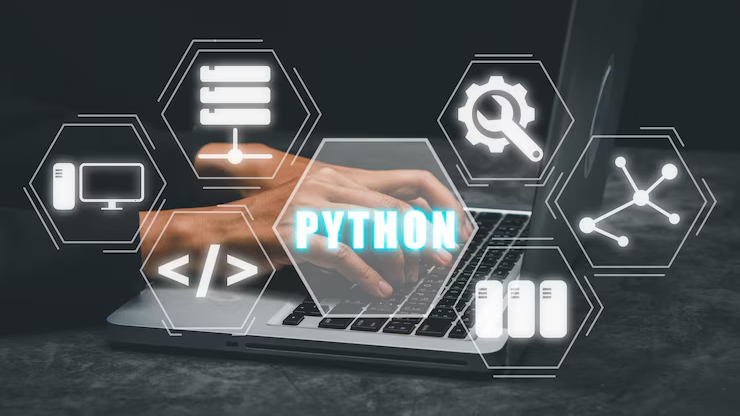Before diving into complex projects, a solid grasp of Python basics is necessary. This includes understanding syntax, data types, variables, and control structures such as loops and conditionals. These fundamentals serve as the building blocks for more advanced concepts and projects.
Syntax and Data Types

Python’s syntax is designed to be intuitive and easy to read. Understanding how to write clean and efficient code is vital. You should also be familiar with different data types such as integers, strings, lists, and dictionaries. Each data type has its own set of operations and uses, which you’ll need to utilize effectively in your programs.
Mastering Python’s syntax involves more than just knowing the rules; it’s about developing a coding style that is both efficient and readable. Emphasizing readability makes your code more maintainable and easier for others to understand. This is crucial when you work in teams or contribute to open-source projects.
Data types are the backbone of any programming language. In Python, understanding how to choose the right data type for your needs can optimize performance and simplify your code. For instance, using a dictionary over a list can drastically reduce lookup times. Familiarity with data types enables you to write more efficient and effective code.
Variables and Memory Management

Variables in Python are dynamic, meaning you don’t need to declare their type explicitly. This flexibility allows for rapid development but requires a good understanding of memory management to avoid inefficient code. Knowing how Python handles memory can help you write programs that are both effective and resource-efficient.
Understanding variables involves knowing how they are stored in memory. In Python, everything is an object, which influences how variables work. Recognizing the difference between mutable and immutable types, for example, is critical for avoiding unintended side effects in your programs.
Memory management in Python involves understanding the garbage collection process. By knowing how Python’s memory allocation works, you can write code that minimizes memory leaks and optimizes resource usage. This is particularly important in applications where performance is a critical concern.
Control Structures

Control structures help you manage the flow of your program. Mastering loops (for and while) and conditionals (if, elif, else) allows you to write programs that make decisions and repeat actions, which are essential for creating dynamic applications.
Control structures are more than just loops and conditionals; they include error handling and exception management. Understanding how to manage exceptions effectively can prevent your program from crashing and provide a better user experience. Implementing proper error handling shows a level of professionalism and foresight in your coding.
Loops are fundamental for iterating over data structures. Understanding the differences between for and while loops, and when to use each, can greatly enhance your coding efficiency. Moreover, mastering list comprehensions can simplify your loops and make your code more Pythonic.
Conditionals allow your program to make decisions. Writing effective conditionals involves more than just knowing the syntax; it requires understanding logic and how to construct efficient decision trees. This skill is essential for writing programs that can adapt to different inputs and scenarios.
Mastering Python Libraries and Frameworks

One of Python’s strengths is its rich ecosystem of libraries and frameworks. These tools allow you to perform complex tasks with minimal code. Whether you’re interested in web development or data analysis, knowing which libraries to use is crucial.
Web Development with Django and Flask
For web development, Django and Flask are two of the most popular frameworks. Django is a high-level framework that encourages rapid development and clean design. Flask, on the other hand, is a micro-framework that gives you more control and flexibility. Understanding how to use these frameworks will enable you to build scalable and robust web applications.
Django is known for its “batteries included” approach, offering built-in features like an ORM, admin interface, and authentication. Familiarity with Django allows for rapid development of full-featured web applications. Its robust nature makes it ideal for larger projects where scalability and security are priorities.
Flask, in contrast, is lightweight and modular. It provides the essentials to get a web app up and running without the overhead of a full-stack framework. This flexibility makes it perfect for smaller projects or when you need to integrate specific components. Mastering Flask means understanding how to extend its capabilities through third-party libraries.
Web development also involves understanding front-end and back-end integration. Knowledge of RESTful services and APIs is crucial when building web applications. These skills ensure that your applications can communicate effectively with other systems, broadening the scope of your projects.
Data Analysis with Pandas and NumPy
For those interested in data science, Pandas and NumPy are indispensable. Pandas offer data structures and functions for working with structured data, while NumPy provides support for large, multi-dimensional arrays and matrices. Mastery of these libraries allows you to efficiently manipulate and analyze data.
Pandas is essential for data wrangling and manipulation. It provides powerful data structures like DataFrames that simplify the process of cleaning and organizing data. Understanding how to use Pandas effectively can streamline your data analysis process and make your work more efficient.
NumPy is the foundation of numerical computing in Python. Its array object is faster and more compact than Python lists, making it ideal for large-scale computations. Mastering NumPy involves understanding how to perform operations on arrays and utilizing its mathematical functions for complex calculations.
Data analysis also requires data visualization skills. Libraries such as Matplotlib and Seaborn build upon NumPy and Pandas to create insightful visualizations. These tools help you interpret data more effectively, making your findings more accessible and compelling to others.
Machine Learning with TensorFlow and Scikit-Learn
Python’s capabilities extend into machine learning with libraries like TensorFlow and Scikit-Learn. TensorFlow is a powerful library for deep learning, enabling you to build complex neural networks. Understanding TensorFlow can open doors to developing AI applications and performing advanced data modeling.
Scikit-Learn is a more general-purpose machine learning library. It provides simple and efficient tools for data mining and data analysis. Mastering Scikit-Learn involves understanding its algorithms and how to apply them to real-world problems, making it indispensable for data scientists.
Machine learning also involves understanding data preprocessing and feature engineering. These steps are crucial for preparing your data for machine learning models. Familiarity with these processes ensures that your models are accurate and reliable, setting the stage for successful machine learning projects.
Developing Problem-Solving Skills

Algorithmic Thinking
Algorithmic thinking involves breaking down a problem into smaller, manageable parts and devising a step-by-step solution. Familiarize yourself with common algorithms and data structures, as these are often the foundation for solving complex problems.
Algorithmic thinking is a crucial skill that goes beyond writing code. It involves understanding computational complexity and optimizing algorithms for better performance. Knowing how to analyze an algorithm’s efficiency helps you make informed decisions about which approach to take.
Data structures like stacks, queues, and trees are fundamental to algorithmic thinking. Mastery of these structures allows you to store and organize data efficiently, which is critical for developing complex applications. Understanding how to implement and utilize these structures can significantly enhance your problem-solving capabilities.
Solving problems often requires creativity and lateral thinking. Developing your ability to think outside the box can lead to innovative solutions that others might overlook. This mindset is essential for tackling unique challenges and pushing the boundaries of what your applications can achieve.
Debugging and Testing
No code is perfect on the first try. Debugging is the process of identifying and fixing errors in your code. Learning to use debugging tools and techniques will save you time and frustration. Additionally, testing your code ensures it behaves as expected. Writing unit tests can help catch bugs early in the development process.
Debugging involves more than just finding errors; it’s about understanding the root cause of a problem. Tools like Python’s built-in debugger and logging module can assist in tracking down issues. Mastering these tools can make the debugging process more efficient and less daunting.
Testing is a proactive approach to ensuring code quality. Writing unit tests involves breaking down your code into testable parts and verifying their functionality. This practice not only helps catch bugs but also ensures that your code remains robust as you make changes.
Integration testing and continuous integration (CI) are advanced testing strategies that ensure your code works in conjunction with other components. Understanding these concepts is crucial for maintaining the integrity of larger projects, especially in collaborative environments.
Embracing Version Control with Git

Branching and Merging
Version control is essential for managing changes to your codebase, especially when working in teams. Git is the most widely used version control system. Understanding how to use Git for branching, merging, and collaborating with other developers is crucial for any Python developer.
Branching allows you to work on new features without affecting the main codebase. Understanding how to create and manage branches is fundamental for organizing your workflow. This skill is essential for developing features simultaneously and ensuring that new code integrates smoothly.
Merging is the process of integrating changes from different branches into the main codebase. Mastering merge strategies and resolving conflicts is crucial for maintaining code integrity. This skill is particularly important in team environments where multiple developers work on the same project.
Using Git effectively involves understanding advanced features like rebasing and cherry-picking. These techniques can streamline your workflow and simplify the process of integrating changes. Mastery of these tools demonstrates a high level of proficiency in version control.
Collaboration and Code Review
Git is not just about managing code; it’s also about collaboration. Platforms like GitHub enable you to share your code and contribute to open-source projects. Engaging in code reviews helps you learn from others and improve your coding skills.
Collaboration on platforms like GitHub involves understanding how to manage pull requests and conduct code reviews. These processes ensure that new code meets quality standards and aligns with project goals. Participating in code reviews also provides valuable feedback and fosters a culture of continuous improvement.
Contributing to open-source projects is a great way to hone your skills and give back to the community. Understanding open-source etiquette and how to navigate project repositories is crucial for making meaningful contributions. This experience not only enhances your resume but also expands your professional network.
Effective communication is key in collaborative environments. Being able to articulate your ideas and understand feedback from others is essential for successful teamwork. This skill is invaluable in code reviews, project discussions, and when seeking help from the community.
Staying Updated with Python Trends

Continuous Learning
The tech world is constantly evolving, and staying updated with the latest Python trends is vital for your career. Follow industry news, join Python communities, and participate in online forums to keep your skills sharp and relevant.
Python, like any other programming language, evolves over time. Continuous learning and adapting to new features and best practices will keep you ahead of the curve. Online courses, webinars, and meetups are great ways to continue your education and stay current with the latest developments in Python programming.
Continuous learning involves more than just keeping up with Python updates; it includes exploring new technologies and methodologies. Being open to learning new programming paradigms or tools can broaden your skill set and make you more versatile as a developer.
Networking with other developers through communities and forums can provide insights into emerging trends and best practices. Engaging with the community can also lead to collaborative opportunities and mentorship. Building relationships with other Python developers can be invaluable for your professional growth.
Participating in hackathons and coding challenges is a practical way to apply new skills and test your knowledge. These events provide real-world scenarios that can enhance your problem-solving abilities and expose you to different perspectives and approaches.
Industry News and Trends
Keeping up with industry news helps you understand the direction in which Python is heading. This knowledge can guide your learning path and career decisions. Following blogs, podcasts, and newsletters can provide a steady stream of information on the latest Python developments.
Understanding trends in data science, artificial intelligence, and web development can inform your learning priorities. As these fields evolve, Python continues to play a central role. Being aware of industry trends ensures that you remain relevant and competitive in the job market.
Exploring Python’s role in emerging technologies like IoT, blockchain, and quantum computing can open new career opportunities. These fields are rapidly growing and present exciting challenges for Python developers. Staying informed about these trends can position you at the forefront of technological innovation.
Conclusion
Becoming a proficient Python developer requires more than just knowing how to write code. It involves a combination of technical skills, problem-solving abilities, and a willingness to learn and adapt. By mastering the essential skills outlined in this article, you’ll be well on your way to a successful career in Python development. Keep practicing, stay curious, and embrace the ever-changing landscape of technology.
Remember, the journey to becoming an exceptional Python developer is a marathon, not a sprint. With dedication and persistence, you’ll achieve your goals and contribute to exciting projects in the Python community.
Leave a Reply